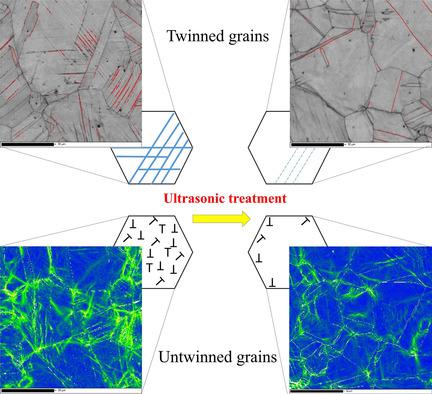当前位置:
X-MOL 学术
›
Steel Res. Int.
›
论文详情
Our official English website, www.x-mol.net, welcomes your feedback! (Note: you will need to create a separate account there.)
Microstructural Evolutions under Ultrasonic Treatment in 304 and 316 Austenitic Stainless Steels: Impact of Stacking Fault Energy
Steel Research International ( IF 2.2 ) Pub Date : 2021-04-15 , DOI: 10.1002/srin.202100041 Milad Zohrevand 1, 2 , Mehrdad Aghaie-Khafri 1 , Farnoosh Forouzan 2 , Esa Vuorinen 2
Steel Research International ( IF 2.2 ) Pub Date : 2021-04-15 , DOI: 10.1002/srin.202100041 Milad Zohrevand 1, 2 , Mehrdad Aghaie-Khafri 1 , Farnoosh Forouzan 2 , Esa Vuorinen 2
Affiliation

|
Herein, the influence of ultrasonic treatment (UST) on the microstructure of AISI-304 and AISI-316 stainless steels as two common commercial grades with similar properties but different levels of stacking fault energy (SFE) is compared. The softening effect of the ultrasonic wave on the predeformed structure is demonstrated by microhardness measurements, and the relaxation of tensile residual stresses is affirmed through the X-ray diffraction (XRD) peak shifting. Electron and optical microscopy reveals a significant impact of ultrasound on the reduction of the deformation twins’ fraction. A new mechanism for detwinning under the action of ultrasonic vibration is proposed using electron backscatter diffraction (EBSD) analysis. Reductions of 25% and 34% are detected in dislocation density of the 10% predeformed tensile sample after 300 W UST for the 304SS and 316SS alloys, respectively. The effect of the SFE is discussed, and it turns out that cross-slip is the main mechanism of dislocation annihilation as a result of UST. Observation of the low-deformation regions close to the grain boundaries indicates the occurrence of the recrystallization phenomenon during UST. Dislocation annihilation, detwinning, dislocation absorption to grain boundaries, and recrystallization are regarded as the softening and relaxation mechanisms of UST for austenitic stainless steels.
中文翻译:

超声处理下 304 和 316 奥氏体不锈钢的显微组织演变:层错能的影响
在此,比较了超声波处理 (UST) 对 AISI-304 和 AISI-316 不锈钢微观结构的影响,这两种不锈钢具有相似的性能,但层错能 (SFE) 水平不同。通过显微硬度测量证明了超声波对预变形结构的软化作用,并通过 X 射线衍射 (XRD) 峰移证实了拉伸残余应力的松弛。电子显微镜和光学显微镜揭示了超声波对变形孪晶分数降低的显着影响。使用电子背散射衍射 (EBSD) 分析提出了一种在超声波振动作用下解缠结的新机制。对于 304SS 和 316SS 合金,在 300 W UST 后,10% 预变形拉伸样品的位错密度分别降低了 25% 和 34%。讨论了 SFE 的影响,结果表明交叉滑移是 UST 导致位错湮灭的主要机制。观察靠近晶界的低变形区域表明在 UST 过程中发生了再结晶现象。位错湮灭、去孪晶、位错吸收到晶界和再结晶被认为是奥氏体不锈钢 UST 的软化和松弛机制。观察靠近晶界的低变形区域表明在 UST 过程中发生了再结晶现象。位错湮灭、去孪晶、位错吸收到晶界和再结晶被认为是奥氏体不锈钢 UST 的软化和松弛机制。观察靠近晶界的低变形区域表明在 UST 过程中发生了再结晶现象。位错湮灭、去孪晶、位错吸收到晶界和再结晶被认为是奥氏体不锈钢 UST 的软化和松弛机制。
更新日期:2021-04-15
中文翻译:

超声处理下 304 和 316 奥氏体不锈钢的显微组织演变:层错能的影响
在此,比较了超声波处理 (UST) 对 AISI-304 和 AISI-316 不锈钢微观结构的影响,这两种不锈钢具有相似的性能,但层错能 (SFE) 水平不同。通过显微硬度测量证明了超声波对预变形结构的软化作用,并通过 X 射线衍射 (XRD) 峰移证实了拉伸残余应力的松弛。电子显微镜和光学显微镜揭示了超声波对变形孪晶分数降低的显着影响。使用电子背散射衍射 (EBSD) 分析提出了一种在超声波振动作用下解缠结的新机制。对于 304SS 和 316SS 合金,在 300 W UST 后,10% 预变形拉伸样品的位错密度分别降低了 25% 和 34%。讨论了 SFE 的影响,结果表明交叉滑移是 UST 导致位错湮灭的主要机制。观察靠近晶界的低变形区域表明在 UST 过程中发生了再结晶现象。位错湮灭、去孪晶、位错吸收到晶界和再结晶被认为是奥氏体不锈钢 UST 的软化和松弛机制。观察靠近晶界的低变形区域表明在 UST 过程中发生了再结晶现象。位错湮灭、去孪晶、位错吸收到晶界和再结晶被认为是奥氏体不锈钢 UST 的软化和松弛机制。观察靠近晶界的低变形区域表明在 UST 过程中发生了再结晶现象。位错湮灭、去孪晶、位错吸收到晶界和再结晶被认为是奥氏体不锈钢 UST 的软化和松弛机制。



























 京公网安备 11010802027423号
京公网安备 11010802027423号